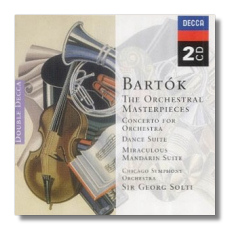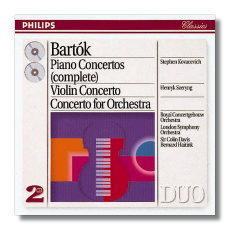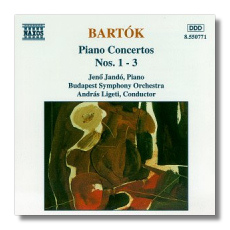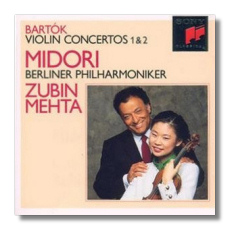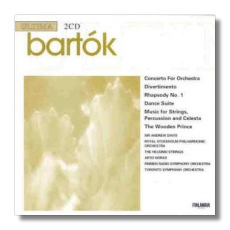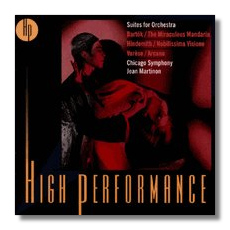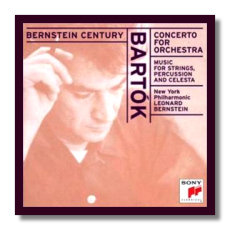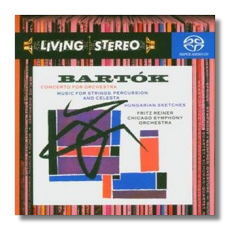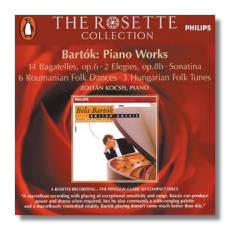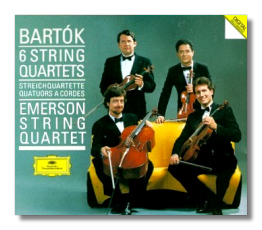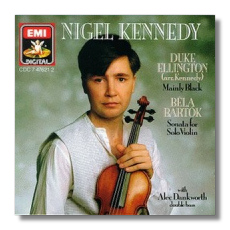
The Internet's Premier Classical Music Source
Related Links
-
Find CDs & Downloads
Amazon - UK - Germany - Canada - France - Japan
ArkivMusic - CD Universe
Find DVDs & Blu-ray
Amazon - UK - Germany - Canada - France - Japan
ArkivMusic-Video Universe
Find Scores & Sheet Music
Sheet Music Plus -
Recommended Links
Site News
Béla Bartók
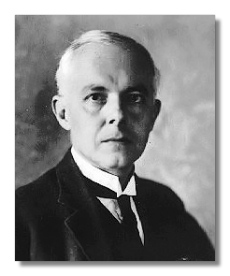
(1881 - 1945)
Teacher, ethnomusicologist, and pianist, Béla Bartók has come to be regarded as one of the most influential Modern composers of the twentieth century, along with Claude Debussy, Arnold Schoenberg, Igor Stravinsky, Paul Hindemith, and Anton Webern. His influence crossed borders, especially strong in postwar Eastern Europe, where the most talented of the new composers followed him, in France where his disciples included Oliver Messiaën and André Jolivet, and in South and Latin Americas. Schoenberg once confided to his student Oscar Levant that Bartók was the second greatest living composer.
Born in what is now Hungary, Bartók studied piano with Thomán, a Franz Liszt pupil, and composition with Hans Koessler, who in turn had studied with Josef Gabriel Rheinberger. These men also taught Ernő Dohnányi, with whom Bartók later took advanced study in piano. Dohnányi was the fair-haired boy in modern Hungarian music circles, and Bartók had an ambivalent relationship with the older man's music.
As a composer, Bartók began as a late Romantic, influenced by Liszt and Richard Strauss. His two major works of this period – the symphonic poem Kossuth and the highly Romantic (and dramatic) Piano Quintet. Neither sounds anything like mature Bartók. Indeed, it took the composer years to find his characteristic voice, although even his early catalogue contains masterpieces.
Bartók quickly became dissatisfied with the late Romantic idiom. Indeed, he had to be persuaded not to destroy his Piano Quintet, which for many years counted as his most popular work.. He began to develop an interest in Hungarian folk music and to incorporate elements into his compositions – for example, the finale to the Second Suite, Op. 4 (1907). About this time he also met fellow composer Zoltán Kodály, who had more ethnological expertise and had actually conducted research in the field. One cannot overestimate the importance of this friendship. Although the two men had their own styles, they became each other's greatest cheerleader and most trusted critic. They submitted their compositions to one another for serious criticism. Kodály not only encouraged research collaborations with Bartók, but also introduced him in a serious way to the music of Debussy, a progressive step for conservative Budapest. The great expression of Debussy's sway over Bartók is probably the opera Bluebeard's Castle (1911), which owes much to Debussy's 1902 Pelléas et Mélisande.
The folk influence on Bartók was cemented in 1907, when the composer traveled to Transylvania. Up to this time, he had concentrated on arrangements of tunes. His journey convinced him that he could base his original music on folk elements. This is reflected in his first violin concerto, unfinished, the first movement of which he recycled into his Two Portraits (1907). The movement is based on a theme, known as the "Geyer" motif, written as homage to a serious girlfriend, who dumped him – hence, the difficulty completing the concerto. Nevertheless, Bartók continued to love the theme, which shows up in much of his piano music of the time and most notably in the First String Quartet (1909). For me, this is Bartók's first unequivocal masterpiece. It's one of the few quartets that can bear up to Beethoven's. Indeed, Bartók's entire cycle of six quartets stands among the best ever written, and they take his compositional concerns at the time of creation to the height of expression. In other words, Bartók's quartets sound like his other works of the time, only more so.
After World War I, Bartók underwent a period of "barbarous," Expressionist gigantism, probably influenced ultimately by Stravinsky's Rite of Spring. He wasn't alone, as one can see in roughly contemporary works by such composers as Prokofiev and Honegger. His major works of this time include the ballet The Miraculous Mandarin (1919; orch. 1924), 3 Studies for Piano (1918), Improvisations on Hungarian Peasant Songs (1922), and the two violin sonatas (1921-22). This most radical phase of his output lasted until 1926.
A fundamental then took place in Bartók's music. As he himself analyzed it, he turned from Beethoven to Bach. The Stravinsky piano concerto decisively pushed him in this direction. Bartók's works became even leaner and formally tighter. This begins his real maturity. Most of the masterpieces we know him for start here: the Piano Sonata (1926), the First Piano Concerto (1926), still tinged with Expressionism, the darkly powerful Cantata profana (1930), the glittering Second Piano Concerto (1931), Mikrokosmos (1931-39), String Quartet #5 (1934), Music for Strings, Percussion, and Celesta (1936), Sonata for Two Pianos and Percussion (1937), the Second Violin Concerto (1938), considered in some circles his finest composition, and String Quartet #6 (1939).
In 1940, Bartók fled Europe for, ultimately, the United States. By then, he was a sick man (it turned out to be leukemia) and knew it. Furthermore, he had trouble earning a living. His concerts were not in demand. He refused to teach composition, insisting that it couldn't be taught. He hoped for academic appointments in ethnomusicology and actually had offers, which he never acted on. Columbia University appointed him to a one-year research position in 1941. From 1940 to 1942, he composed almost nothing – his longest fallow period, and considering the stress he suffered for himself and his family, not surprising – but he came back with a roar, writing two of his best-loved works: Concerto for Orchestra (1944) and the Third Piano Concerto (1945). In both, one hears a less austere, warmer Bartók, one who wants to sing as beautifully as he can. Of course, those who suspect popularity give him grief for these two works, seeing them somewhat as sellouts. I doubt it, myself. Not only were Bartók's attempts to sell out somewhat laughable (he arranged his Sonata for Two Pianos and Percussion as a concerto for two pianos and orchestra), the scores themselves contain the same architectural rigor as his thornier pieces. Some scholars believe that a renewed interest in the works of Edvard Grieg sparked a new accessibility. In addition, he composed a Sonata for Solo Violin, his final chamber masterpiece, influenced by the C-major solo sonata by Bach, in which he returns to his thorny old self. Besides, he composed light works throughout his career. Finally, Bartók began but did not live to finish a viola concerto. His countryman Tibor Serly realized the only authorized completion of the work, but it has many problems, chief among them the incompatibility of Bartók's and Serly's idioms. Far better and far closer to Bartók is the completion by violist Csaba Erdélyi, but through legal maneuvering, Bartók's publishers have kept it from gaining any currency.
Both the Concerto for Orchestra and the Third Piano Concerto received successful premieres and almost-immediate repertory status, among the last works of the Modern era to do so, but it's still early days yet. Performers continue eagerly to play his music, and companies haven't been shy about recording it. Unlike Schoenberg and Stravinsky, he established no compositional "school" and taught composition only when he couldn't avoid it, but his music seems to have helped composers of many different aesthetic orientations to find their individual voices. His work inspires all on its own. ~ Steve Schwartz

Recommended Recordings
 Concerto for Orchestra
Concerto for Orchestra
- Concerto; Music for Strings, Percussion & Celesta/Sony SMK60730
-
Leonard Bernstein/New York Philharmonic Orchestra
- Concerto; Music for Strings, Percussion & Celesta; Hungarian Sketches/RCA Living Stereo 09026-61504-2
-
Fritz Reiner/Chicago Symphony Orchestra
- Concerto; Music for Strings, Percussion & Celesta/London 421443-2
-
Charles Dutoit/Montréal Symphony Orchestra
- Concerto with Lutosławski/London 425694-2
-
Christoph von Dohnányi/Cleveland Orchestra
- Concerto/London Double Decca 470516-2 or Decca Legends 467686-2
-
Georg Solti/Chicago Symphony Orchestra
 Concertos for Piano (
Concertos for Piano ( 3)
3)
- Piano Concertos #1-3, Violin Concerto #2 & Concerto for Orchestra/Philips Duo 438812-2
-
Stephen Bishop Kovacevich (piano), Colin Davis/London Symphony Orchestra & BBC Symphony Orchestra
- Piano Concertos #1-3, Piano Music/Philips 446368-2
-
Zoltán Kocsis (piano), Iván Fischer/Budapest Festival Orchestra
- Piano Concertos #1-3/Naxos 8.550771
-
Jénö Jandó (piano), András Ligeti/Budapest Symphony Orchestra
- Piano Concertos #1 & 2, Portraits Op. 5/Deutsche Grammophon 415371-2 or Reissues
-
Maurizio Pollini (piano), Claudio Abbado/Chicago Symphony Orchestra
- Piano Concertos #1-3/Deutsche Grammophon Originals 447399-2
-
Géza Anda (piano), Ferenc Fricsay/Berlin Radio Symphony Orchestra
- Piano Concertos #1-3, Violin Concertos/London Double Decca 473271-2
-
Vladimir Ashkenazy (piano), Georg Solti/London Philharmonic Orchestra
- Piano Concerto #3 with Prokofieff, Gershwin, de Falla, Stravinsky & Ravel/Philips Duo 462859-2
-
Stephen Bishop Kovacevich (piano), Colin Davis/London Symphony Orchestra
Concertos for Violin
- Violin Concertos #1 & 2, Piano Concertos/London Double Decca 473271-2
-
Kyung-Wha Chung (violin), Georg Solti/Chicago Symphony Orchestra & London Philharmonic Orchestra
- Violin Concertos #1 & 2/Sony SK45941
-
Midori (violin), Zubin Mehta/Berlin Philharmonic Orchestra
- Violin Concerto #2, Solo Violin Sonata/EMI Références 69804-2 or 574799-2
-
Yehudi Menuhin (violin), Wilhelm Furtwängler/Philharmonia Orchestra
Dance Suite for Orchestra
- Dance Suite/London Double Decca 470516-2 or Decca Legends 467686-2
-
Georg Solti/Chicago Symphony Orchestra
- Dance Suite, Concerto for Orchestra/Hungaroton HCD31167
-
Iván Fischer/Budapest Festival Orchestra
- Dance Suite with Concerto for Orchestra, etc./Finlandia Ultima 8573-81965-2
-
Jukka-Pekka Saraste/Toronto Symphony Orchestra
Miraculous Mandarin (ballet)
- Suite "The Miraculous Mandarin" with Concerto for Orchestra & Dance Suite/London Double Decca 470516-2 or Decca Legends 467686-2
-
Georg Solti/Chicago Symphony Orchestra
- Suite "The Miraculous Mandarin" with Hindemith & Varèse/RCA High Performance 09026-63315-2
-
Jean Martinon/Chicago Symphony Orchestra
- "The Miraculous Mandarin" (Complete) with Music for Strings, Percussion and Celesta, etc./London Double Decca 448276-2
-
Antál Doráti/Detroit Symphony Orchestra & Kenneth Jewell Chorale
Music for Strings Percussion & Celesta
- Music for Strings, Percussion & Celeste with Concerto/Sony SMK60730
-
Leonard Bernstein/New York Philharmonic Orchestra
- Music for Strings, Percussion & Celeste with Concerto/RCA Living Stereo 09026-61504-2
-
Fritz Reiner/Chicago Symphony Orchestra
- Music for Strings, Percussion & Celeste with Concerto for Orchestra/London 421443-2
-
Charles Dutoit/Montréal Symphony Orchestra
- Music for Strings, Percussion & Celeste with Miraculous Mandarin, etc./Double Decca 448276-2
-
Antál Doráti/Detroit Symphony Orchestra & Kenneth Jewell Chorale
- Music for Strings, Percussion & Celeste with Orchestral Works/London Double Decca 470516-2
-
Georg Solti/Chicago Symphony Orchestra
- Music for Strings, Percussion & Celeste/Philips 416831-2
-
Iván Fischer/Budapest Festival Orchestra
Piano Music
- Piano Music (Vol. 1-3)/Philips 446368-2
-
Zoltán Kocsis (piano)
- Piano Music (Vol. 1)/Philips Penguin Rosette Collection 476165-7
-
Zoltán Kocsis (piano)
- Piano Music: Sonata, Out of Doors, Romanian Dances, Hungarian folksongs, Bagatelles, Sonatina, etc./Philips 50 464676-2
-
Zoltán Kocsis (piano)
- Dance Suite, "Hungarian Peasant Songs", "Roumanian Folk Dances", Rondos/Denon C37-7092
-
András Schiff (piano)
- Sonata, Seven Sketches, "Hungarian Peasant Songs and Dances", "Four Dirges", Allegro Barbaro/Eroica JDT-30000
-
June de Toth (piano)
 Quartets for Strings
Quartets for Strings
- String Quartets #1-6/Deutsche Grammophon 423657-2
-
Emerson Quartet
- String Quartets #1-6/London-Decca 455297-2
-
Takács Quartet
- String Quartets #1-6/Deutsche Grammophon 445241-2
-
Tokyo Quartet
- String Quartets #1-6/Hyperion Dyad CDD22003
-
New Budapest Quartet
Sonata for Solo Violin
- Solo Violin Sonata with Ellington/EMI CDC747621-2
-
Nigel Kennedy (violin)
- Solo Violin Sonata with Duets for 2 Violins/Naxos 8.550868
-
György Pauk (violin)
- Solo Violin Sonata with Sonatas for Violin & Piano/Virgin Classics VC545668-2
-
Christian Tetzlaff (violin)
- Solo Violin Sonata with Bach & Paganini/Philips 420948-2
-
Viktoria Mullova (violin)














